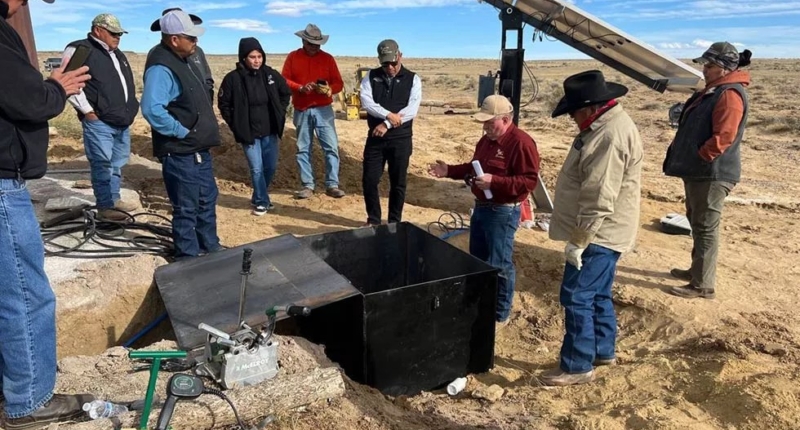Navajo Nation ranchers in New Mexico face water scarcity, which limits their ability to raise more cattle. However, Remote Well Solutions has developed a new off-grid water production and distribution system to solve this problem. The technology can replace aging windmills with hybrid solar-generator systems that pump water from wells and distribute it to multiple irrigation points. The project is expected to increase carrying capacities and create more than 200 additional jobs, contributing nearly $18 million per year to the state’s economy. The technology is also expected to have far-reaching effects, as it can address challenges on similar farms throughout the Southwest. The Navajo Nation Department of Agriculture is working with Remote Well Solutions to initiate additional projects within the eastern region of the reservation. The potential impact of Remote Well Solutions is significant for the Navajo Nation ranchers and the state’s economy.
New Technology to Revolutionize Water Distribution for NM Ranchers
Remote Well Solutions, a company founded by Mike Lisk, has designed and patented an innovative water production and distribution system to help ranchers like George Tso in Navajo Nation who face challenges of water scarcity. Tso, who maintains 51 head of cattle, had been facing difficulties in raising additional cattle due to the lack of a water source on the north side of his nine-square-mile ranch. However, Lisk’s new off-grid water production and distribution system will replace aging windmills with hybrid solar-generator systems that pump water from wells and distribute it to multiple irrigation points, thus making water more accessible for the cattle.
According to Lisk, ranchers like Tso have better land with more forage, but have been unable to raise more animals due to water scarcity. With the new technology, cattle can remain in one area, and the grass grows abundantly in the other areas. The efficiency improvements offered by the system will pay off quickly for the cattle, ranch, and rancher, as water challenges are resolved, and quantifiable results will be almost immediate.
The Arrowhead Center at New Mexico State University conducted a study in 2018 on the economic impacts of installing Remote Well Solutions systems in McKinley County. The study, written by Arrowhead Center program director Kramer Winingham, business consultant Dale Spencer, and graduate student Ejiro Osiobe, found that carrying capacity on McKinley County ranches is four animal units per section on average.
With the new system, ranchers can have better access to water, thereby increasing the carrying capacity of their ranches. Remote Well Solutions’ technology could revolutionize water distribution, making it possible for ranchers like Tso to raise more cattle, and enabling them to use their land to its full potential. The technology is expected to have far-reaching effects, solving water problems for NM ranchers, and bringing about positive economic impacts for the state.
New Technology to Revolutionize NM Ranchers’ Economy and Job Market
Navajo Nation ranchers in New Mexico may soon see an increase in carrying capacities by up to 100% with the installation of the new water production and distribution project technology developed by Remote Well Solutions. While still lower than the typical carrying capacities of ranchers in the state, the technology is expected to increase the performance of local ranchers and improve grazing land. It will also have a profound impact on the state’s economy, with the potential to create over 200 additional jobs and contribute nearly $18 million per year.
The technology can double or triple the income potential of ranches in the area, making it one of the best economic development opportunities in the state. The project is very exciting as it can address challenges on similar farms throughout the Southwest. The Navajo Nation Department of Agriculture is working with Remote Well Solutions to initiate additional projects within the eastern region of the reservation, which consists of regions in Utah, Arizona, and New Mexico. Ferdinand Notah, program and project specialist with the Navajo Department of Agriculture, said that this will allow for better use of forage vegetation on tribal ranches, improve cattle weight gain, improve farm profits, and increase revenue from leasing programs.
The project has been praised by Myron Lizer, who was vice president of the Navajo Nation when the Remote Well Solutions project was first released. He believes that the project will help support local Navajo ranchers, and the cattle will not have to be concentrated at a water point, thus improving grazing land. The project will also help prolong the equipment, fuel, and finances of ranchers.
The Arrowhead Center at New Mexico State University has also been impressed with the technology and its impact on the state’s economy. The director and CEO, Kathy Hansen, said that they are excited to help bring a technology developed in New Mexico to market that is solving real challenges in the state.
The Remote Well Solutions technology is expected to benefit everyone, including ranchers like George Tso, who hopes to expand his ranch once the system is up and running. He believes that it will allow them to raise more cattle and make more money, and in return, buy the things they need to run a ranch. The technology is a big step in the right direction to support local Navajo ranchers, and its potential impact is significant not only in New Mexico but beyond, as it can address challenges on similar farms throughout the Southwest.
Don’t miss interesting posts on Famousbio
